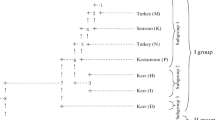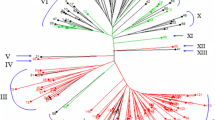Abstract
Genetic diversity was investigated in 73 accessions of emmer wheat (Triticum dicoccon Schrank) from 11 geographical regions using a set of 29 simple-sequence repeat (SSR or microsatellite) markers, representing at least two markers for each chromosome. The SSR primers amplified a total of 357 different alleles with an average of 12.31 alleles per locus. The number of fragments detected by each primer ranged between 6 (Xgwm1066) and 21 (Xgwm268). Null alleles were detected in nine of the 29 primers used. A high level of gene diversity index was observed. Across the 29 primers, gene diversity ranged from 0.60 (Xgwm46) to 0.94 (Xgwm655), with a mean of 0.82. There was a highly significant correlation (r=0.882; p<0.01) between gene diversity index and the number of loci, showing the number of loci per se is a strong indicator of diversity. Analysis of genetic diversity within and among eleven geographical regions revealed most of the genetic diversity of the total sample resided within regions. The coefficient of gene differentiation (Gst = 0.27) showed that the genetic variation within and among the 11 geographical regions was 73 and 27%, respectively. High value of mean number of alleles per locus was found in Iran (4.86) followed by Morocco (4.10) and Armenia (4.03). On the contrary, lower mean number of alleles per locus was detected in Yemen (2.83). The average gene diversity index across regions ranged from 0.52 (Slovakia) to 0.67 (Morocco) with an average of 0.60. Multivariate techniques of principal component analysis and clustering were employed to examine genetic relationship among the 73 emmer wheat accessions vis-à-vis geographical regions of collections. The genetic distance coefficients for all possible 55 pairs of regional comparisons ranged from 0.63 (between Iran and Armenia, Georgia and Azerbaijan, Georgia and Slovakia) to 0.97 (between Morocco and Yemen, Spain and Georgia, and Turkey and Iran) with a mean of 0.82. From the PCA results, a two dimensional plot of PC1 versus PC2 was constructed. The scatter plot of the first two principal components which explained altogether 27% of the total variation depicted the presence of a clear pattern of geographical differentiation except in few cases like accessions from Caucasian region. Similar pattern of genetic relationships among accessions was observed in cluster analysis. The study provided genetic information of emmer wheat in relation to geographical regions of origin. The information could be utilized in crop improvement, germplasm conservation programs, and in further investigation.
Similar content being viewed by others
References
Auricchio S., Occorsio P. and Silano V. (1982). Effects of gliadin-derived peptides from bread and durum wheat on small-intestine culture from rat fetus and celiac children. Pediatr. Res. 16: 1004–1010
Barcaccia G., Molinari L., Porfiri O. and Veronesi F. (2002). Molecular characterization of emmer (Triticum dicoccon Schrank) Italian landraces. Genet. Resour. Crop Evol. 49: 415–426
Bertin P., Gregoire D., Massart S. and de Froidmont D. (2001). Genetic diversity among European cultivated spelt revealed by microsatellites. Theor. Appl. Genet. 102: 148–156
Bretting P.K. and Widrlechner M.P. (1995). Genetic markers and plant genetic resources. Plant Breed. Rev. 13: 11–86
Cavalli-Sforza L.L., Menozzi P. and Piazza P. (1994). History and Geography of Human Genes. Princeton University Press, Princeton, NY
Chowdhury M.A. and Slinkard A.E. (2000). Genetic diversity in grasspea (Lathyrus sativus L.). Genet. Resour. Crop Evol. 47: 163–169
Corazza L., Pasquini M. and Perrino P. (1986). Resistance to rusts and powdery mildew in some strains of Triticum monococcum L. and Triticum dicoccum Schubler cultivated in Italy. Genet. Agrar. 40: 243–254
D’Antuono L.F. (1989). I1 farro; areali di coltivazionecaratteristiche agronomicheutilizzazione e prospettive colturali. L’Informatore Agrario 45: 49–57
Dai X. and Zhang Q. (1989). Genetic diversity of six isozyme loci in cultivated barley of Tibet. Theor. Appl. Genet. 78: 281–286
Damania A.B., Hakim S. and Moualla M.Y. (1992). Evaluation of variation in Triticum dicoccum for wheat improvement in stress environments. Hereditas 116: 163–166
Devos K.M., Bryan G.J., Collins A.J. and Gale M.D. (1995). Application of two microsatellite sequences in wheat storage proteins as molecular markers. Theor. Appl. Genet. 90: 247–252
Dice L.R. (1945). Measures of the amount of ecologic association between species. Ecology 26: 297–302
Donini P., Stephenson P., Bryan G.J. and Koebner R.M.D. (1998). The potential of microsatellites for high throughput genetic diversity assessment in wheat and barley. Genet. Resour. Crop Evol. 45: 415–421
Dorofeev V.F., Filatenko A.A., Migušova E.F., Udain R.A. and Jakubciner M.M. 1979. Pšenica. Kul’turnaja Flora SSSR, Vol. 1. Leningrad, Russia, 347 pp.
Dvorak J., Luo M.C., Yang Z.L. and Zhang H.B. (1998). The structure of the Aegilops tauschii genepool and the evolution of hexaploid wheat. Theor. Appl. Genet. 97: 657–670
Eujayl I., Sorrells M., Baum M., Wolters P. and Powell W. (2001). Assessment of genotypic variation among cultivated durum wheat based on EST-SSRS and genomic SSRS. Euphytica 119: 39–43
Fahima T., Röder M.S., Grama A. and Nevo E. (1998). Microsatellite DNA polymorphism divergence in Triticum dicoccoides accessions highly resistant to yellow rust. Theor. Appl. Genet. 96: 187–195
Fahima T., Röder M.S., Wendehake K., Kirzhner V.M. and Nevo E. (2002). Microsatellite polymorphism in natural populations of wild emmer wheatTriticum dicoccoides in Israel. Theor. Appl. Genet. 104: 17–29
Feldman M. (1979). Wheats (Triticum spp.). In: Simmonds, N.W. (eds) Evolution of Crop Plants, pp. Longman Group Limited, London
Figliuolo G. and Perrino P. (2004). Genetic diversity and intra-specific phylogeny of Triticum turgidum L. subsp. dicoccon (Schrank) Thell. revealed by RFLPs and SSRs. Genet. Resour. Crop Evol. 51: 519–527
Filatenko A.A., Grau M., Knüpffer H. and Hammer K. (2001). Wheat Classification – John Percival's contribution and the approach of the Russian School. The Linnean Society of London, Special Issue No. 3: 165–184
Fulton T.M., Chunwongse J. and Tanksley D. (1995). Microprep protocol for extraction of DNA from tomato and other herbaceous plants. Plant Mol. Biol. Rep. 13: 207–209
Gökgöl M. (1955). Bugdaylarin Tansif Anahtari. Ziraat Vekaleti Yayin. No. 76, Istambul; Turkey
Hammer K. and Perrino P. (1984). Further information on farro (Triticum monococcum L. and Triticum dicoccon Schrank) in South Italy. Kulturpflanze 32: 143–151
Hammer K., Filatenko A.A., Al-Khanjari S., Al-Maskri A.Y. and Buerkert A. (2004). Emmer (Triticum dicoccon Schrank) in Oman. Genet. Resour. Crop Evol. 51: 111–113
Harlan J.R. (1955). The great plains region (Part 4). Agric. Food Chem. 3: 29–31
Harlan J.R. (1971). Agricultural origins: centers and noncenters. Science 174: 468–474
Harlan J.R. and Zohary D. (1966). Distribution of wild wheats and barley. Science 153: 1074–1080
Helbaeck H. (1959). Domestication of food plants in the old world. Science 130: 365–372
Huang X.Q., Börner A., Röder M.S. and Ganal M.W. (2002). Assessing genetic diversity of wheat (Triticum aestivum L.) germplasm using microsatellite markers. Theor. Appl. Genet. 105: 699–707
Koenig R. and Gepts P. (1989). Allozyme diversity in wild Phaseolus vulgaris: further evidence for two major centers of genetic diversity. Theor. Appl. Genet. 78: 809–817
Kresovich S., Williams J.G.K., McFerson J.R., Routman E.J. and Schaal B.A. (1992). Characterization of genetic identities and relationships of Brassica oleracea L. via a random amplified polymorphic DNA assay. Theor. Appl. Genet. 85: 190–196
Krivchenko V.I., Yamaleyev A.M., Isayev R.F. and Gorbunova V.Y. (1979). Role of wheat seed huskiness in bunt resistance. Mycol. Phytopathol. 13(4): 330–333
Laghetti G., Piergiovanni A.R., Volpe N. and Perrino P. (1999). Agronomic performance of Triticum dicoccon Schrank and T. spelta L. accessions under Southern Italian conditions. Agr. Med. 129: 199–211
Nei M. (1973). Analysis of gene diversity in subdivided populations. Proc. Natl. Acad. Sci. USA 70: 3321–3323
Nei M. and Chesser R.K. (1983). Estimation of fixation and gene diversities. Ann. Hum. Genet. 47: 253–259
Nei M. and Li W.H. (1979). Mathematical model for studying genetic variation in terms of restriction endonucleases. Proc. Natl. Acad. Sci. USA 76: 5269–5273
Nesbitt M. and Samuel D. (1996). From staple crop to extinction? The archaeology and history of the hulled wheats. In: Padulosi, S., Hammer, K. and Heller, J. (eds) Hulled Wheats, pp. IPGRI, Rome
Peña-Chocarro L. 1996. In situ conservation of hulled wheat species: the case of Spain. In: Padulosi S., Hammer K. and Heller J.(eds) Hulled Wheats. Promoting the conservation and use of underutilized and neglected crops. Proc. of 1st Int. Workshop on Hulled Wheats, July, 21–22, 1995. Castelvecchio Pascoli, Lucca, Italy, pp. 129–146.
Perrino P., Laghetti G., D’Antuono L.F., Al Ajlouni M., Kanbertay M., Szabó A.T. and Hammer K. 1996. Ecogeographical distribution of hulled wheat species. In: Padulosi S., Hammer K. and Heller J.(eds) Hulled wheats. Proc. Int. Workshop. Castelvecchio PascoliItaly, pp. 101–119.
Pflüger L.A., Martín L.M. and Alvarez J.B. (2001). Variation in the HMW and LMW glutenin subunits from Spanish accessions of emmer wheat (Triticum turgidum ssp. dicoccum Schrank). Theor. Appl. Genet. 102: 767–772
Piergiovanni A.R. and Blanco A. (1999). Variation of HMW glutenin and γ-gliadin subunits in selected accessions of Triticum dicoccum (Schrank) and T. spelta (L.). Cereal Res. Commun. 27: 205–211
Plaschke J., Ganal M.W. and Röder M.S. (1995). Detection of genetic diversity in closely related bread wheat using microsatellite markers. Theor. Appl. Genet. 91: 1001–1007
Röder M.S., Korzun V., Wendehake K., Plaschke J., Tixier M.H., Leroy P. and Ganal M.W. (1998). A microsatellite map of wheat. Genetics 149: 2007–2023
Röder M.S., Wendehake K., Korzun V., Bredemeijer G., Loborie D., Bertranel L., Isaac P., Rendell S., Jackson J., Cooke R.J., Vosman B. and Ganal M.W. (2002). Construction and analysis of a microsatellite-based database of European wheat varieties. Theor. Appl. Genet.: 163–169
Rohlf F.J. 1998. NTSYS-pc: numerical taxonomy and multivariate analysis systemvers. 2.0. Applied Biostatistics Inc., New York.
Serret M.D., Udupa S.M. and Weigand F. (1997). Assessment of genetic diversity of cultivated chickpea using microsatellite-derived RFLP markers: implications for origin. Plant Breed. 116(6): 573–578
Sharma H.C., Waines J.C. and Foster K.W. (1981). Variability in primitive and wild wheats for useful genetic characters. Crop Sci. 21: 555–559
Srivastava J.P. and Damania A.B. (1989). Use of collections for cereal improvement in semi-arid areas. In: Brown, A.H.D., Frankel, O.H., Marshall, D.R. and Williams, J.T. (eds) The Use of Plant Genetic Resources, pp 88–104. Cambridge University Press, UK
Stallknecht G.F., Gilbertson K.M. and Romey J.E. (1997). Alternative wheat cereals as good grains: Einkorn, emmerspeltkamutand triticale. In: Janick, J. (eds) Progress in New Crops, pp 156–170. ASHS Press, Alexandria VA
Szabó A.T. and Hammer K. 1996. Notes on the taxonomy of farro: Triticum monococcum, T. dicoccon and T. spelta. In: Padulosi S., Hammer K. and Heller J.(eds) Hulled Wheats. Promoting the Conservation and Use of Underutilized and Neglected Crops. Proc. of 1st Int. Workshop on Hulled Wheats, July, 21–22, 1995, Castelvecchio PascoliLuccaItaly, pp. 2–40.
Tautz D. and Renz M. (1984). Simple sequences are ubiquitous repetitive components of eukaryotic genomes. Nucl. Acids Res. 23: 249–255
Teklu Y. and Hammer K. 2006. Farmers perception and genetic erosion of Ethiopian tetraploid wheat landraces. Genet. Resour. Crop Evol. (in press).
Teklu Y., Hammer K., Huang X.Q. and Röder M.S. 2006. Analysis of microsatellite diversity in Ethiopian tetraploid wheats. Genet. Resour. Crop Evol. (in press).
Vavilov N.I. (1931). The Linnaean species as a system. Tr. po Prikl. Bot. Genet. Sel. [Bull. Appl. Bot. Genet. Sel.] 26(3): 109–134
Vavilov N.I. 1964. World resources of cereals, legumes, flax cultivars and their utilization in breeding. Wheat. Nauka, Moskow and Leningrad.
Author information
Authors and Affiliations
Corresponding author
Rights and permissions
About this article
Cite this article
Teklu, Y., Hammer, K. & Röder, M.S. Simple sequence repeats marker polymorphism in emmer wheat (Triticum dicoccon Schrank): Analysis of genetic diversity and differentiation. Genet Resour Crop Evol 54, 543–554 (2007). https://doi.org/10.1007/s10722-006-0011-7
Received:
Accepted:
Published:
Issue Date:
DOI: https://doi.org/10.1007/s10722-006-0011-7




